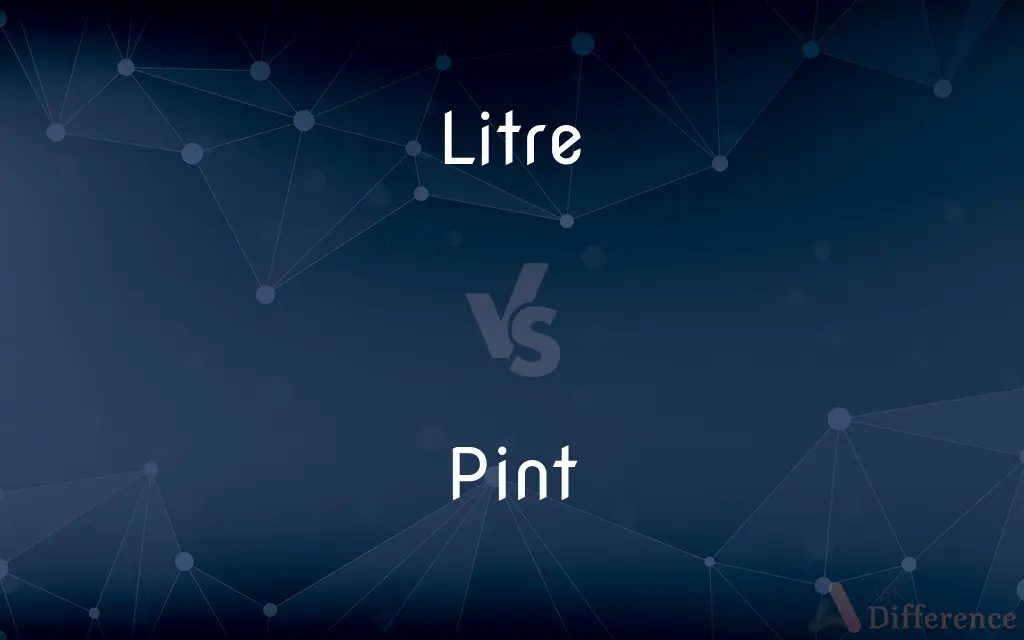Litre vs. Pint — What's the Difference?
By Fiza Rafique & Maham Liaqat — Updated on March 15, 2024
A litre is a metric unit of volume equal to 1,000 cubic centimeters, widely used globally, while a pint is an imperial unit of volume, smaller than a litre, and varies between the US (473.176 mL) and the UK (568.261 mL).

Difference Between Litre and Pint
Table of Contents
ADVERTISEMENT
Key Differences
The litre, denoted as "L," is a standard unit of volume in the metric system, commonly used around the world for measuring liquid and dry substances. It is defined as the volume of a cube that is 10 centimeters on each side, making it equivalent to 1,000 cubic centimeters (cm³) or 1 cubic decimeter (dm³). The pint, on the other hand, is used in the imperial system (UK) and the US customary system, with a notable difference in size between the two: the US pint is equal to 473.176 milliliters, whereas the UK pint is larger, at 568.261 milliliters. This distinction is important in contexts such as cooking, brewing, and legal measurements, where precision in volume is crucial.
While the litre serves as a universal unit for volume in countries that have adopted the metric system, the pint remains in use primarily in the United States, the United Kingdom, and a few other countries for specific applications, particularly in serving sizes for beverages like beer and milk. The use of the litre allows for straightforward conversion within the metric system, facilitating international trade and scientific communication. In contrast, the use of the pint can lead to confusion due to its varying definitions, requiring clarity on whether the measurement is based on the US or UK pint.
In everyday contexts, the litre is often preferred for its simplicity and ease of conversion with other metric units. For example, measuring fuel efficiency, container capacities, and beverage volumes is commonly done in litres. The pint, however, holds cultural significance in regions like the UK, where traditional pub servings of beer and cider are still measured in pints, embedding the unit into social practices and consumer expectations.
The choice between using litres and pints can also reflect broader differences in measurement systems, with the metric system being recognized for its decimal-based simplicity and the imperial system retaining historical and cultural relevance in specific settings. This dichotomy illustrates the ongoing coexistence of metric and imperial units in global and local contexts.
Comparison Chart
Definition
A metric unit of volume equal to 1,000 cubic centimeters.
An imperial unit of volume, with US and UK variants (473.176 mL in the US, 568.261 mL in the UK).
ADVERTISEMENT
System
Metric
Imperial (UK) and US Customary
Common Uses
Used globally for measuring liquids and solids in a variety of contexts.
Used for beverages, cooking, and some agricultural products, primarily in the US and UK.
Conversion
1 litre = 1,000 milliliters (mL)
1 US pint = 473.176 mL; 1 UK pint = 568.261 mL
Cultural Aspect
Widely accepted in countries using the metric system.
Holds cultural significance in the UK and US, especially in traditional settings like pubs.
Compare with Definitions
Litre
A unit of volume in the metric system.
She bought a 2-litre bottle of soda for the party.
Pint
A unit of volume in the imperial and US customary systems.
He ordered a pint of craft beer at the pub.
Litre
Commonly used for packaging and labeling liquids.
The engine oil comes in 5-litre containers.
Pint
Used for serving sizes in bars and pubs, especially in the UK.
A pint of milk is a daily necessity for many families.
Litre
Used in everyday life for liquid quantities.
The car's fuel efficiency is 8 litres per 100 kilometers.
Pint
Employed in agricultural measurements in the US.
Strawberries are often sold by the pint at markets.
Litre
Utilized in scientific and medical measurements.
The lab experiment required 0.5 litres of distilled water.
Pint
Varies between the US and UK measurements.
The recipe required a pint of blueberries.
Litre
Integral to the metric system for volume.
The recipe called for 1 litre of chicken broth.
Pint
Reflects cultural practices in beverage consumption.
Traditional British pubs serve ale by the pint.
Litre
The litre (British English spelling) or liter (American English spelling) (SI symbols L and l, other symbol used: ℓ) is a metric unit of volume. It is equal to 1 cubic decimetre (dm3), 1000 cubic centimetres (cm3) or 0.001 cubic metre (m3).
Pint
The pint (, listen ; symbol pt, sometimes abbreviated as p) is a unit of volume or capacity in both the imperial and United States customary measurement systems. In both of those systems it is traditionally one eighth of a gallon.
Litre
Variant of liter.
Pint
A unit of liquid or dry capacity equal to one eighth of a gallon, in Britain equal to 0.568 litre and in the US equal to 0.473 litre (for liquid measure) or 0.551 litre (for dry measure).
Litre
The metric unit of fluid measure, equal to one cubic decimetre. Symbols: l, L, ℓ
You should be able to fill four cups with one litre of water.
Pint
A unit of volume or capacity in the US Customary System, used in liquid measure, equal to 1/8 gallon or 16 ounces (0.473 liter).
Litre
(informal) A measure of volume equivalent to a litre.
Pint
A unit of volume or capacity in the US Customary System, used in dry measure, equal to 1/16 peck or 1/2 quart (0.551 liter).
Litre
Same as Liter.
Pint
A unit of volume or capacity in the British Imperial System, used in dry and liquid measure, equal to 0.568 liter. See Table at measurement.
Litre
A metric unit of capacity equal to the volume of 1 kilogram of pure water at 4 degrees centigrade and 760 mm of mercury (or approximately 1.76 pints)
Pint
A container with a pint capacity.
Pint
The amount of a substance that can be held in such a container.
Pint
A unit of volume, equivalent to:
Pint
One eighth of a gallon, specifically:
Pint
(Hungary) 1.696 liters
Pint
(medicine) 12 fluid ounces
Pint
A pint of milk.
Please leave three pints tomorrow, milkman.
Pint
A glass of beer or cider, served by the pint.
A couple of pints please, barman.
Pint
A measure of capacity, equal to half a quart, or four gills, - used in liquid and dry measures. See Quart.
Pint
The laughing gull.
Pint
A British imperial capacity measure (liquid or dry) equal to 4 gills or 568.26 cubic centimeters
Pint
A United States dry unit equal to 0.5 quart or 33.6 cubic inches
Pint
A United States liquid unit equal to 16 fluid ounces; two pints equal one quart
Common Curiosities
Can the pint and litre be used interchangeably?
Due to their different volumes, they cannot be directly interchanged without conversion, especially considering the distinction between US and UK pints.
Why do some countries still use the pint?
The pint remains in use due to historical, cultural, and legal reasons, particularly in the US and UK, where it is ingrained in certain practices like beverage serving.
Why is the litre preferred in scientific measurements?
The litre is preferred for its compatibility with the metric system, facilitating easy conversion and international standardization.
Are there legal implications for using litres vs. pints?
Legal requirements for product labeling and trade can dictate the use of litres or pints, varying by country and industry standards.
What is a litre?
A litre is a metric unit of volume equal to 1,000 cubic centimeters, used for measuring liquids and solids.
What are common uses for litres and pints?
Litres are widely used for beverages, fuel, and various liquid measurements, while pints are often used for serving beer and milk, especially in the UK and US.
Why is the metric system, including litres, preferred internationally?
The metric system's decimal-based structure simplifies calculations and conversions, promoting consistency in international communication and commerce.
How does a US pint differ from a UK pint?
A US pint equals 473.176 milliliters, while a UK pint is larger, at 568.261 milliliters.
How is the litre symbolized?
The litre is symbolized by the letter "L," and it can be either uppercase or lowercase.
How do cultural practices influence the use of pints?
In regions like the UK, traditional practices such as serving beer in pubs by the pint continue to reinforce the use of this measurement.
Is the litre or pint more accurate for measurements?
Accuracy depends on the context and the precision required; the litre offers ease of use with metric conversions, while the pint can be precise in systems familiar with imperial measurements.
What is the significance of the pint in the brewing industry?
The pint is a standard serving size for beer in many English-speaking countries, especially in the UK, shaping consumer expectations and industry practices.
How do conversion errors between litres and pints impact practical applications?
Inaccurate conversions can lead to significant discrepancies in recipes, scientific experiments, and trade, highlighting the importance of clarity and precision.
Share Your Discovery

Previous Comparison
Palletized vs. Palletised
Next Comparison
Torso vs. BodyAuthor Spotlight
Written by
Fiza RafiqueFiza Rafique is a skilled content writer at AskDifference.com, where she meticulously refines and enhances written pieces. Drawing from her vast editorial expertise, Fiza ensures clarity, accuracy, and precision in every article. Passionate about language, she continually seeks to elevate the quality of content for readers worldwide.
Co-written by
Maham Liaqat














































